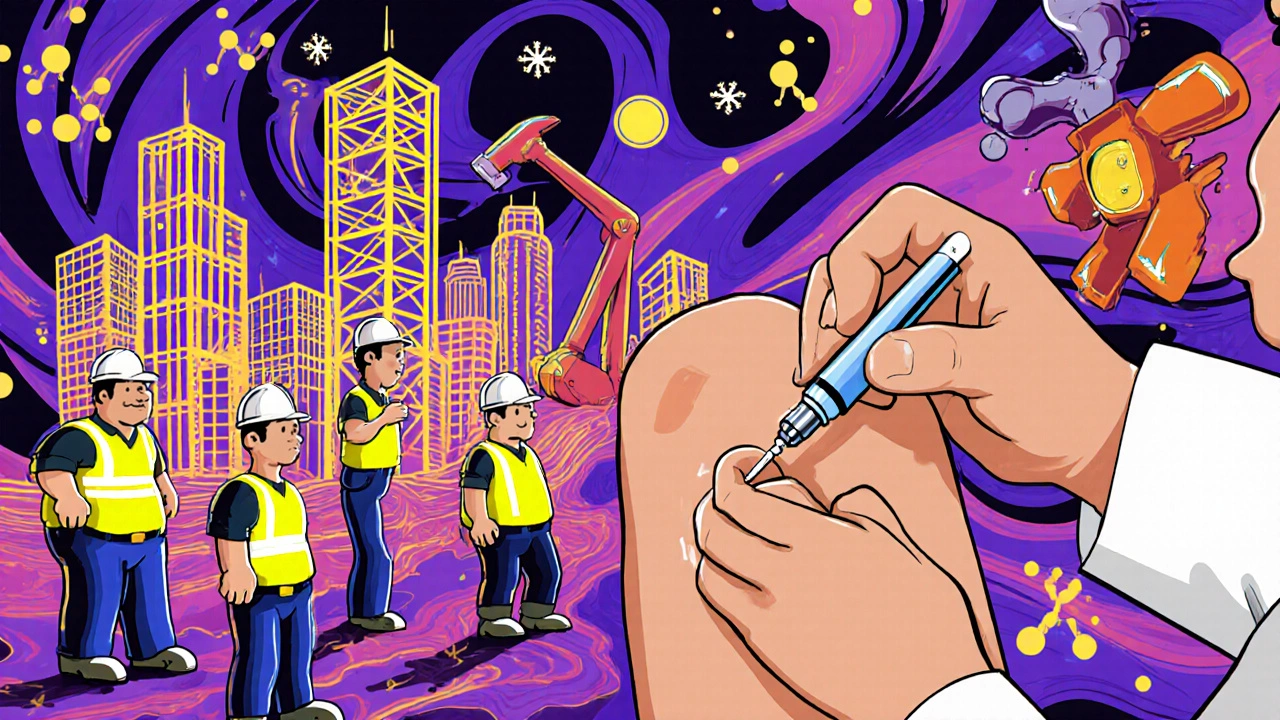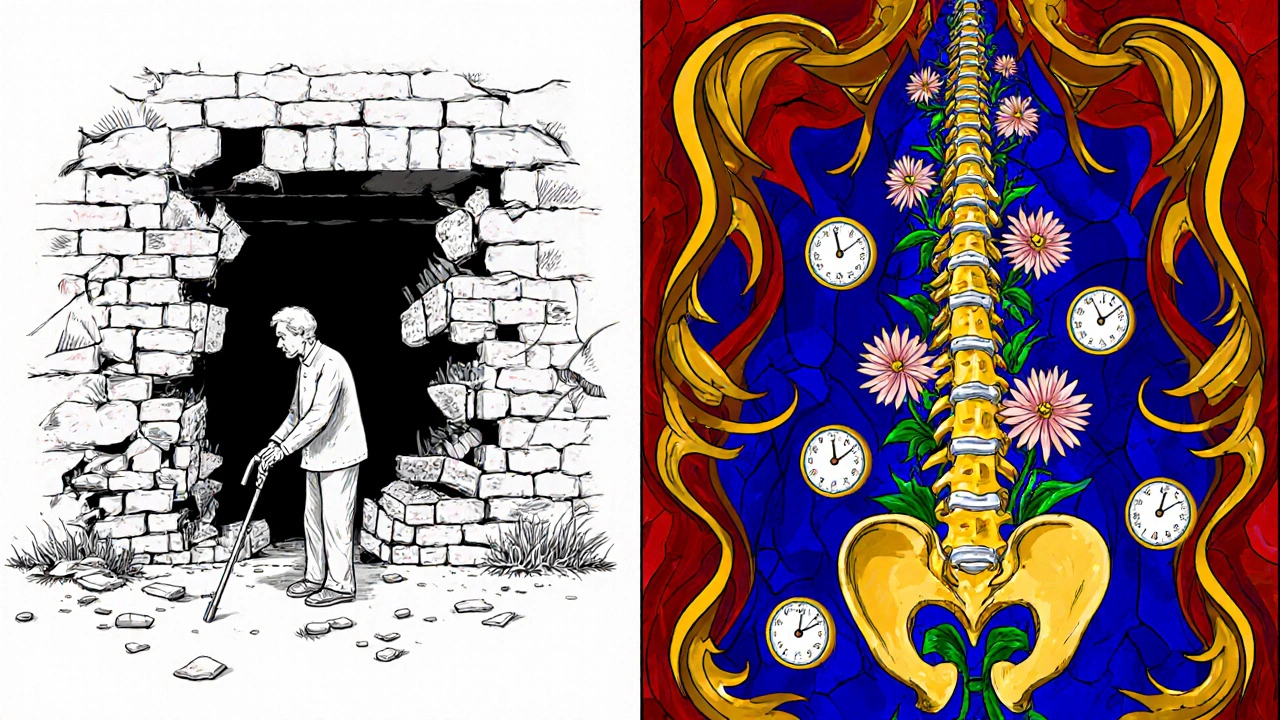
When you hear the word osteoporosis, you probably think of weak bones, fractures, or older adults. But what if the key to rebuilding those bones isn’t just calcium and vitamin D - but a hormone your body already makes?
Parathyroid hormone (PTH) is one of the most powerful tools we have to fight osteoporosis. It’s not a supplement you take daily like a vitamin. It’s a targeted treatment that tells your bones to grow - not just slow down their loss. And it works differently than any other osteoporosis drug on the market.
What Parathyroid Hormone Actually Does
Your parathyroid glands are four tiny nodes behind your thyroid. They don’t make thyroid hormone - they make parathyroid hormone. And its job? Keep your blood calcium level steady. When calcium drops, PTH kicks in. It pulls calcium from your bones into your bloodstream. That sounds bad, right? But here’s the twist: when you give PTH as a medicine, it doesn’t just take calcium out - it rebuilds bone.
That’s because PTH works in pulses. When it’s released naturally, it’s in short bursts. When given as a daily injection (like teriparatide or abaloparatide), it mimics that natural rhythm. The bone cells - osteoblasts - respond by making new bone faster than old bone is broken down. In clinical trials, patients using daily PTH injections saw up to a 10% increase in spine bone density over 18 months. That’s more than double what you get from most bisphosphonates.
Why It’s Different from Other Osteoporosis Drugs
Most osteoporosis treatments - like alendronate (Fosamax), risedronate (Actonel), or denosumab (Prolia) - are anti-resorptive. They slow down bone loss. They’re good at stopping the bleed. But they don’t rebuild.
PTH is anabolic. It builds. Think of it like this: other drugs are like putting a tarp over a leaking roof. PTH is like hiring a contractor to rebuild the whole roof - new shingles, stronger beams, better insulation.
That’s why doctors turn to PTH for patients with severe osteoporosis - especially those who’ve already broken a hip or spine bone, or whose bone density hasn’t improved after two years on other meds. The FDA approved teriparatide in 2002 specifically for high-risk patients. And it’s still one of the few drugs proven to reduce new spine fractures by more than 65%.
Who Gets PTH Therapy - and Who Doesn’t
Not everyone with osteoporosis needs PTH. It’s not a first-line treatment. It’s reserved for:
- People with very low T-scores (below -3.0)
- Those who’ve had multiple fractures despite other treatments
- Postmenopausal women and men over 60 with severe disease
- Patients on long-term steroid use who’ve lost bone mass
But it’s not for everyone. You can’t use PTH if you’ve had radiation to your bones, Paget’s disease, or bone cancer. It’s also not approved for people under 18. And you can’t take it for more than two years total - lifetime. After that, your doctor will switch you to an anti-resorptive drug to hold the gains.
Cost is another factor. A month’s supply of teriparatide can run over $1,200 without insurance. Even with coverage, copays can hit $100+. That’s why many doctors try cheaper drugs first. But if your bones keep breaking, the cost of a hip fracture - surgery, rehab, long-term care - can be 10 times higher.

How It’s Given - And What to Expect
PTH comes as a daily injection under the skin, usually in the thigh or stomach. The dose is small - 20 micrograms for teriparatide, 80 micrograms for abaloparatide. You get a pen-like device with a tiny needle. Most people say the sting is less than a mosquito bite.
Side effects are mild. Some feel dizzy for a few hours after the shot. A few report nausea or leg cramps. High calcium levels can happen, so your doctor will check your blood every few months. You’ll also need to avoid too much calcium from supplements - more than 1,200 mg a day can raise your risk of kidney stones.
It’s not a magic bullet. You still need to get enough vitamin D, eat protein, and do weight-bearing exercise. Walking 30 minutes a day, lifting light weights - these aren’t optional. They help the new bone stick.
What Happens After Two Years?
Two years is the max. After that, your body stops responding as strongly. That’s why doctors don’t restart PTH later - it doesn’t work as well the second time.
Instead, you move to a drug that protects what you’ve built. Denosumab is often the next step. It blocks bone breakdown and keeps your new bone from melting away. Some patients switch to romosozumab, a newer anabolic drug that builds bone and slows loss at the same time. But even then, you’re not going back to PTH.
Studies show that patients who follow PTH with denosumab keep 80% of their bone gains after five years. Those who stop all treatment? They lose nearly all of it within two years.
The Big Picture: Bone Is Alive
For decades, we thought of bone as a static structure - like a brick wall. Now we know it’s more like a living city. Cells are constantly tearing down and rebuilding. Osteoclasts remove old bone. Osteoblasts lay down new. In osteoporosis, the demolition crew outnumbers the builders.
PTH is the only treatment that flips the script. It doesn’t just slow the wrecking balls. It hires more builders. That’s why, for the right person, it’s not just another drug - it’s a second chance to walk without fear.

Real-World Results
Take Maria, 68, from Chicago. She broke her wrist at 62, then her spine at 65. Her T-score was -4.1. She tried alendronate for 18 months. Her bone density didn’t budge. Her doctor switched her to teriparatide. After 18 months, her spine density rose 12%. She stopped using her cane. She started gardening again.
Or James, 72, who had three vertebral fractures after prostate cancer treatment. He couldn’t sit for more than 10 minutes. After 12 months on abaloparatide, he walked 5 miles without pain. His fracture risk dropped by 70%.
These aren’t outliers. They’re what happens when you treat osteoporosis like a disease that can be reversed - not just managed.
What You Need to Ask Your Doctor
If you’ve been diagnosed with severe osteoporosis, here are five questions to ask:
- Is my bone density low enough to consider PTH therapy?
- Have I tried at least one other drug without success?
- Do I have any history of bone cancer or radiation?
- What’s the cost, and does my insurance cover it?
- What drug will I take after the two-year PTH course?
Don’t assume PTH is too expensive or too risky. Ask for the numbers - your T-score, your fracture history, your options. If your doctor doesn’t mention PTH, ask why. It’s not a last resort - it’s a powerful tool for the right patient.
Can parathyroid hormone cure osteoporosis?
No, it doesn’t cure osteoporosis. But it can rebuild lost bone and significantly lower your risk of fractures. After treatment ends, you’ll need to stay on another medication to protect your new bone. Osteoporosis is a chronic condition - PTH gives you a major advantage, not a permanent fix.
Is parathyroid hormone the same as calcium supplements?
No. Calcium supplements feed your bones, but they don’t tell them to grow. Parathyroid hormone is a signaling molecule that activates bone-building cells. You need both: calcium for raw material, and PTH to use it. Taking extra calcium won’t replace PTH therapy.
Why can’t I take PTH longer than two years?
Animal studies showed a small risk of bone cancer with very long-term use. While no human cases have been confirmed, regulators set a strict two-year lifetime limit as a safety precaution. After two years, the bone-building effect fades, and switching to another drug is more effective than continuing.
Do I need to stop other osteoporosis drugs before starting PTH?
Yes. Most doctors recommend stopping bisphosphonates or denosumab for at least 30 days before starting PTH. These drugs suppress bone turnover too much, and PTH needs active bone cells to work. Starting too soon can reduce its effectiveness.
Can men use parathyroid hormone for osteoporosis?
Yes. While osteoporosis is more common in women, men over 65 with low bone density and fractures respond just as well. The FDA approved teriparatide for men in 2003. Studies show similar increases in bone density and fracture reduction in men as in women.
Next Steps If You’re Considering PTH
Start by getting a DEXA scan if you haven’t had one in the last year. Ask your doctor for your T-score - anything below -2.5 means osteoporosis. If you’ve had a fracture and your score is below -3.0, PTH may be your best option.
Check your insurance coverage. Some require prior authorization or proof that other drugs failed. Ask about patient assistance programs - manufacturers often offer discounts for those who qualify.
And don’t wait. The longer you wait, the more bone you lose. PTH works fastest in the first six months. If you’re a candidate, starting now could mean walking without pain next year - not five years from now.
8 Comments
Robert Gilmore November 20, 2025 AT 02:21
PTH isn't a drug-it's a biological hack. It hijacks the body's calcium homeostasis pathway and flips the anabolic switch. Osteoblasts don't just respond-they're *reprogrammed*. This isn't medicine. It's epigenetic reengineering with a syringe.
Robert Gilmore November 21, 2025 AT 11:56
They say PTH rebuilds bone… but who controls the parathyroid glands? Big Pharma? The FDA? Or the shadow network that quietly altered our calcium metabolism since the 80s? They gave us PTH because they needed us to believe bone could be fixed-so we’d keep buying pills instead of asking why our bones rot in the first place.
Robert Gilmore November 21, 2025 AT 15:48
Wait-you’re telling me a hormone that *leeches* calcium from bone is now a *bone builder*? That’s like saying a arsonist who burns down your house is now your interior designer because he rebuilt it with nicer wood. This is medical gaslighting. And the two-year limit? That’s not safety-it’s a planned obsolescence loop. You get hooked, then they sell you the next drug. Classic.
Robert Gilmore November 23, 2025 AT 07:13
Teriparatide’s efficacy is statistically significant-but clinically overhyped. The 10% density gain? That’s in the spine. Hip density? Minimal change. And let’s not ignore the 12% incidence of transient hypercalcemia. You want anabolic? Try resistance training + vitamin K2 + collagen peptides. Cheaper. Safer. No FDA-mandated time bomb.
Robert Gilmore November 24, 2025 AT 01:10
PTH therapy? Sure. But why not ask why 78% of patients on bisphosphonates still fracture? Systemic inflammation. Gut dysbiosis. Chronic cortisol elevation. We treat the symptom, not the cause. The bone is just the messenger. The real disease? Modern life. And no drug can fix that.
Robert Gilmore November 24, 2025 AT 18:35
They call it a ‘second chance’? Nah. It’s a temporary reprieve-like giving a drowning man a life jacket made of wet paper. You rebuild bone… then hand them denosumab like it’s a miracle. But denosumab? It’s a bone-murdering trap. You stop it? BOOM-fracture storm. This isn’t treatment. It’s a rigged game where Big Pharma owns the dice.
Robert Gilmore November 24, 2025 AT 20:48
For anyone considering PTH: talk to your endocrinologist, get your vitamin D levels checked, and pair it with daily weight-bearing exercise. Don’t just rely on the injection. Bone responds to stress-walking, lifting, even standing more. The drug opens the door, but you have to walk through it. And yes, insurance can be a nightmare-but patient assistance programs exist. Ask. Don’t assume.
Robert Gilmore November 26, 2025 AT 08:47
They say it’s safe… but what about the rats? The ones that got bone cancer after 2 years? They buried that. And now we’re told to trust them? You think they care about your spine? They care about the $1,200/month. This isn’t medicine-it’s a cash cow with a needle. And you? You’re the cow.